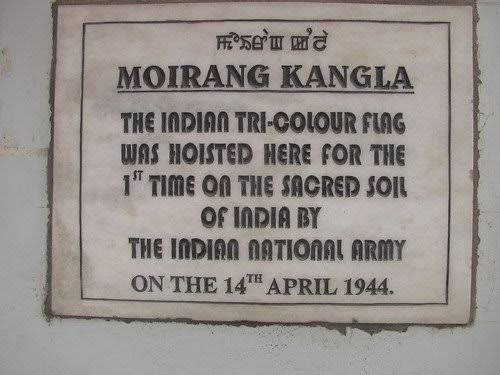Netaji’s Azad Hind Fauj had captured Moirang from the British Army on April 14, 1944. It was the first victory of Indian National Army, also known as Azad Hind Fauj against the British Army in India.
It is one of the fiercest battles in world history refered by Military historians.
On April 14, 1944, Colonel Shaukat Ali Malik of the Indian National Army (Azad Hind Fauj) had marched into Moirang along with his soldiers and had hoisted the national flag.
Moirang is a small town of Manipur in Bishenpur district, situated about 45 km south of Imphal.
During the battle, people of Moirang had played a pro-active role in guiding the Azad Hind Fauj soldiers to lay a valiant siege on the British Army in the eastern theatre.
The Indian National Army (Azad Hind Fauj) was an army of 60,000 soldiers, raised on foreign soil, consisting of prisoners of War and Indians mainly based southeast Asia, who were ready to fight for India’s freedom.
Unfortunately, almost 26,000 of the Indian National Army (Azad Hind Fauj) soldiers gave up their lives fighting for India’s freedom. The formation had no distinction religion or caste or creed.
The formation of the Azad Hind Fauj began in 1942 with the efforts of iconic figures like Rashbehari Bose and Captain Mohan Singh.
The arrival of Netaji Subhash Chandra Bose in South East Asia in 1943 and took over as the supreme commander of Indian National Army. It gave a new filip to the formation.
The charisma of the new leader of the Indian National Army (Azad Hind Fauj), not only gave a new dimension to the army of the liberation, but it challenged the might of the British Empire, which had never happened before. Subhash Chandra Bose became the supreme commander of the Azad Hind Fauj and the new commander believed that one has to fight for freedom.
On October 21, 1943, the provisional government of Indian National Army (Azad Hind Fauj) was established. Netaji Subhash Chandra Bose was the first head of the state and the first PM of the provisional government.
Moirang remained under the control of the Azad Hind Government for nearly four months and it is a matter of pride for the people of Manipur. During that period, currency and stamps of the Azad Hind Fauj government were also used.
The main instrument of the Indian Nationalism (The Indian National Congress), had always maintained a distance from Subhash Chandra Bose during the World War II. But people of Manipur (especially Moirang), were always with Netaji Subhash Chandra Bose, and were never petrified with the British Army during the Battle of Imphal.
Every year April 14 is celebrated as “Moirang Day” or the “Victory Day”.
At last, people of Manipur recognize that the Azad Hind Fauj may have had lost the battle in Imphal, but had won the war for India.
Netaji Subhash Chandra Bose continued to remain as the “Forgotten Hero” of India’s freedom struggle, contribution of Moirang also remained “forgotten” by the Indians.
Every year a small function used to be held in Moirang on this day, but the importance of “Moirang Day” or “Victory Day” was never told.
The provisional government of the Arzi Hukumat-e-Azad Hind was established on October 21, 1943, and Netaji Subhash Chandra Bose became the first head of the state of united free India. Netaji was also the first prime minister , minister of war and minister of foreign affairs of the provisional government of united free India. Netaji was the last prime minister of united free India.
About Azad Hind Fauj
The Arzi Hukumat-e-Azad Hind was an Indian provisional government established in Japanese occupied Singapore during World War II. It was created in October 1943 and supported by Empire of Japan. The government of Azad Hind (Indian National Army) had its own currency, court and civil code, and in the eyes of some Indians, its existence gave a greater importance to the independence struggle against British. Immediately after the formation of the provisional government, Azad Hind Fauj declared war against the Allied forces on the Indo-Burma Front. Its army , the Azad Hind Fauj , went into action against the British Indian Army and the allied forces as part of the Imperial Japanese Army in the Imphal-Kohima sector. The Indian National Army had its first major engagement at the Battle of Imphal where, under the command of the Japanese Fifteenth Army, it breached the British defences in Kohima, reaching the salient of Moirang before suffering a catastrophic defeat as the Allied forces held, and Allied air dominance and compromised supply lines forced both the Japanese and the Indian National Army to retreat.
The existence of the Azad Hind Fauj was essentially coterminous with the existence of the Indian National Army (Azad Hind Fauj). While the Azad Hind government continued until the civil administration of the Andaman Islands was returned to the jurisdiction of the British towards the end of the war, the limited power of Azad Hind Fauj was effectively ended with the surrender of the last major contingent of Indian National Army troops in Rangoon. The disappearance of Bose is seen as the end of the entire Azad Hind movement.










